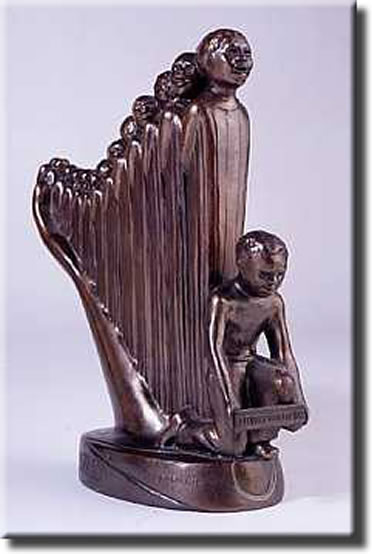During the 1930s Augusta Savage was an African American women artist, who was a sculptor during the 20th century. Savage was born on February 29, 1892, in Green Cove Springs, Florida, and original birth name was Augusta Christine Fells. Augusta died on March 26, 1962 in New York, New York. "Augusta Savage was one of the few visual artist involved in the previous decade's cultural movement known as The Harlem Renaissance and one of the most influential artist working in New York's Harlem" (Chadwick 316). Savage fought for African American artist like herself to be included in the organization called "WPA". Besides fighting for the rights of African American artist, Savage "became an instructor at the WPA-supported Harlem Community Art Center and a major force in training of younger African American artists" (Chadwick 316).
When we look at the 20th century in terms of societal conditions, we see a wide range of issues that are affecting America at this time. These inequalities included political, social, economic factors America is still in the mist of a depression, making it hard for individuals like Augusta, who were of African American decent and faced a tremendous amount of discrimination. On top of all that Savage was a women artist sculpting during the time before the second World War, making it even harder to find a program to support her. But this did not stop Savage from seeking support from programs to help support her work. "A 1935 survey of professional and technical workers on relief revealed that among artists receiving aid, approximately forty-one percent were women" (Chadwick 316) and the program that supported the struggles of women during at that time was the "WPA". This precise organization helped Augusta in her struggles as an artist and funded her art.
"The Harp"
Augusta choose the mediums of expressing her art through the use of sculptures. Each of the numerous sculptures that she created, had its own significance at the time it was made. The picture above labeled "The Harp" was one of Augusta's more famous sculptures. Augusta was commissioned by the Works Progress Administration (WPA) to create a sculpture for the 1939 New York's World Fair. Augusta Savage's inspiration for this master piece came from "some of the lyrics of the poem "Lift Every Voice and Sing," she created "The Harp"(TBC 1). Many of the sculptures made by Augusta would depict many members of the African community from ordinary people to famous individuals. But all her work had some relation tying back to the African American community. In this one specific sculpture, Augusta depicts the face of two African Americans. The first one appears at the top of the harp strings, and the sound board of the instrument's has been transformed into a hand and arm. While the other is depicted kneeling, while holding music and offering it. This sculpture was destroyed after the World Fair of 1939.
Another famous piece by Augusta in which she express through her creative sculpting skills was the "The Pugilist" shown that the bottom. In this sculpture we see that Savage has again chosen to depict the upper half of an African American male. In this painting we see "The Pugilist" confronts the world with his head tilted upward and arms folded ready to take any challenge that his life will prsent him. "The statue also expresses the way that Savage shaped her personality. "The Pugilist" has a positive mood that symbolizes a strong person"(RCT).
 |
| "The Pugilist" |
Augusta savage will always be remember for her artistic works and people in the community of Harlem remember "Augusta Savage as an artist, activist, and arts educator, serving as an inspiration to the many that she taught, helped, and encouraged."(TBC 1). Augusta was one the most influential artist that has ever work in Harlem. Savages artistic work and her teachings will always have a lasting influence on contemporary artists. Augusta was a unselfish individual always looking to give back to her community and fight for the rights of her people. "I have created nothing really beautiful, really lasting, but if I can inspire one of these youngsters to develop the talent I know they possess, then my monument will be in their work." (T. R. Poston).
http://www.youtube.com/watch?v=MyS3HPInHtI
This link above is the song that inspired Agusta Savage to Sculpt "The Harp"
"Augusta Savage." 2013. The Biography Channel website. Nov 07 2013, 11:13http://www.biography.com/people/augusta-savage-40495.
Chadwick, Whitney. Women, Art, and Society. 4th. New York: Thames & Hudson, 2007. Print.
RC Templates, ed. Agusta Savage. Melissa Moxley, 8 Dec. 2011. Web. 7 Nov. 2013.
<https://sites.google.com/site/newdealartmuseum/gallery/agusta>.
T. R. Poston, "Augusta Savage,"Metropolitan Magazine, Jan. 1935, n.p"


No comments:
Post a Comment